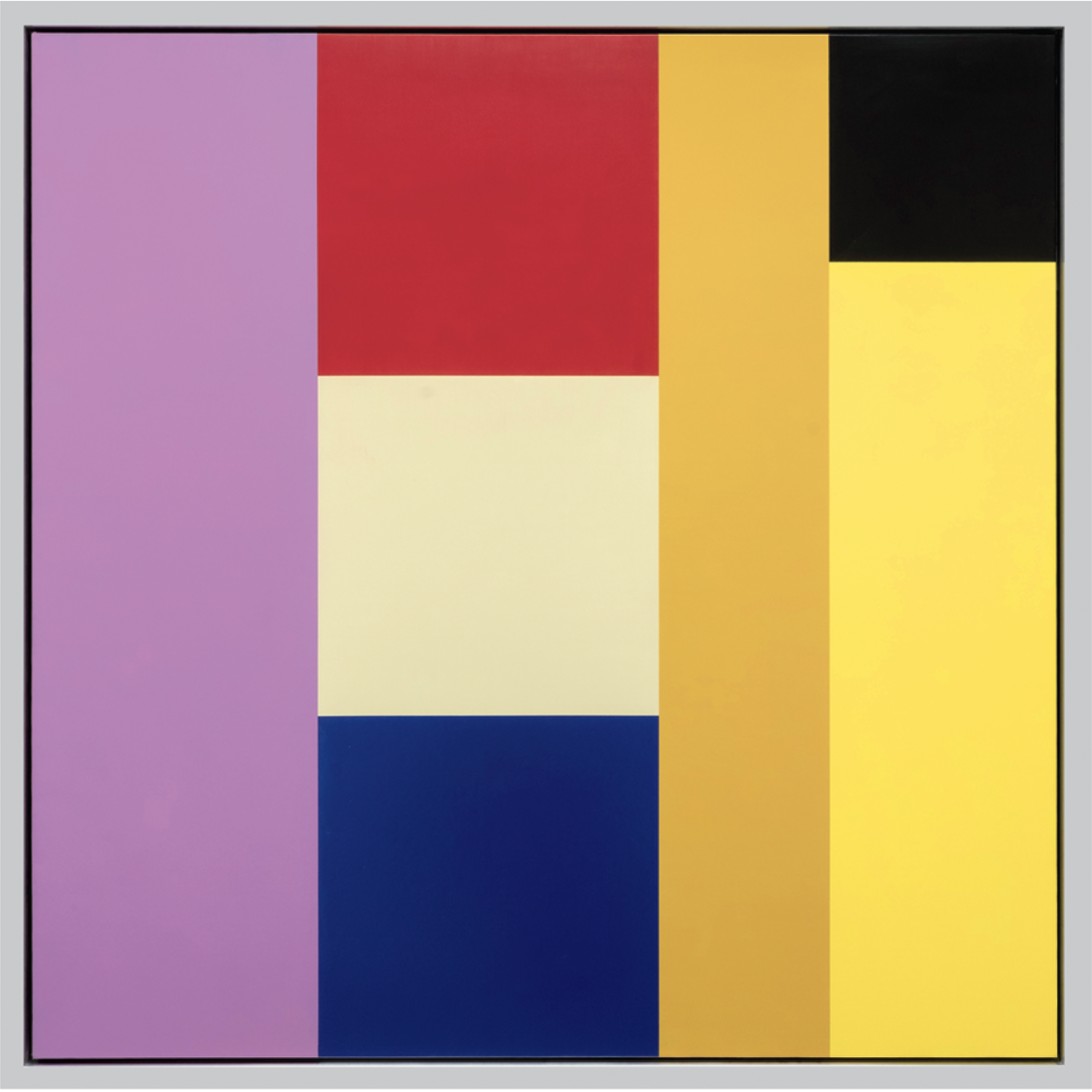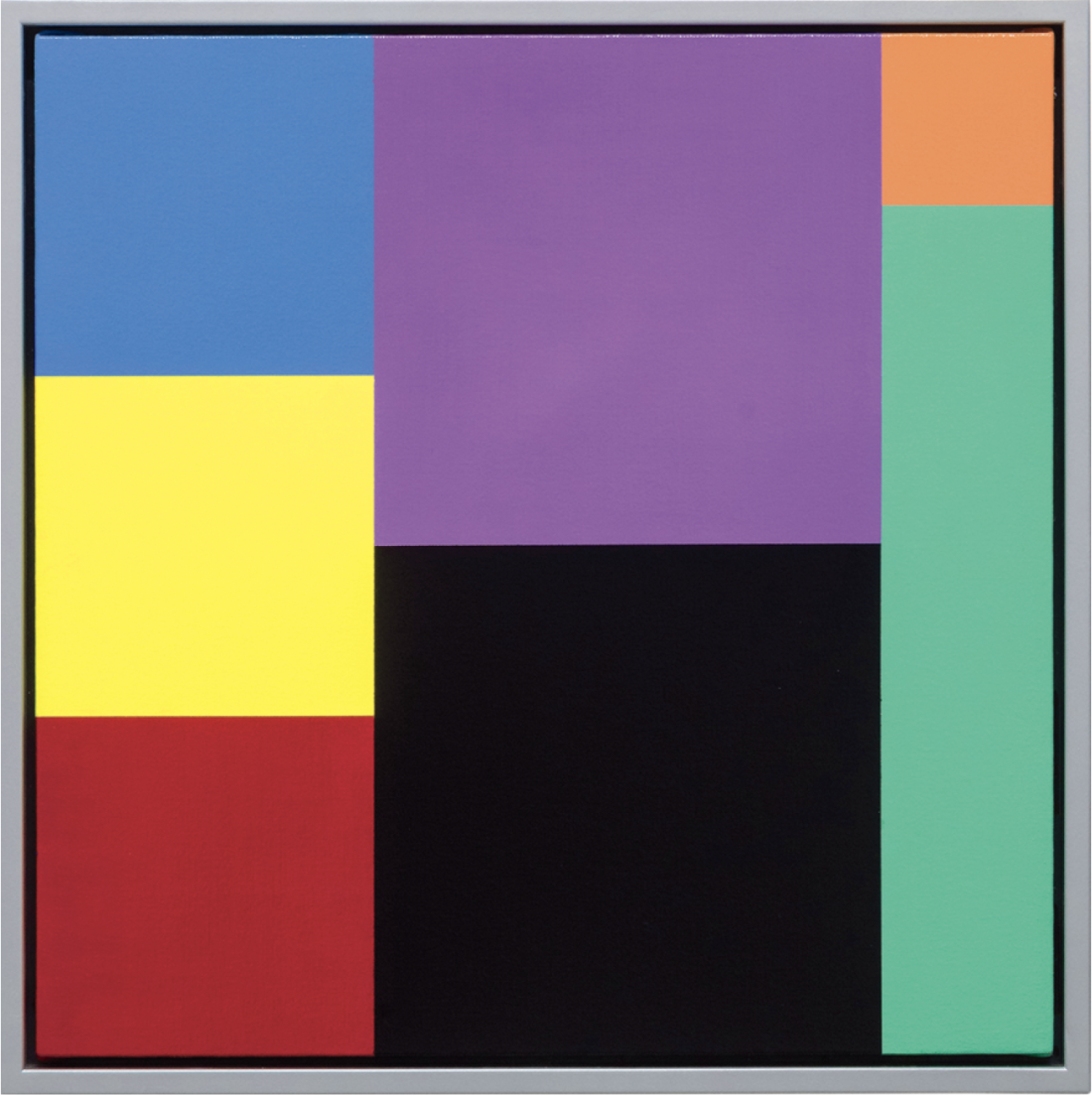Jaan Poldaas
Jaan Poldaas stands important in Toronto painting for bridging the theoretical chasm between abstract painting and conceptual art, two practices often at odds. “Jaan Poldaas: 2016” at Birch Contemporary certainly reinforces his position as a “thinking painter,” through the witty language games of his paintings’ titles, but more overtly his paintings’ formal conventions. The 10 exhibited works display a risky, bold colour range, a significant departure for a painter who has frequently worked with a palette of pleasing mid-value primaries or even monochromes. Moreover, these new paintings manifest more subjective and spontaneous colour choices than his earlier work, which he rendered in strict accordance to predetermined guidelines often based on simple mathematical formulae.
Poldaas has not entirely abandoned conscious picture making. He achieves an overall consistency by canvas shape: the exhibited paintings are on mid-sized square canvases, either 60 by 60 centimetres or 121 by 121 centimetres. The second consistency is compositional. All the paintings comprise seven shapes: horizontal bars, vertical bars and squares. These shapes vary in arrangement from painting to painting. Still, colour differentiates the compositions more than form. Poldaas has presented a wide, bolder colour range with more striking juxtapositions than he has in earlier works. In Bapaneli, 2017, for example, a vertical row of primaries on the painting’s left side diversifies to light purple, pumpkin and turquoise as you look rightward. Yet, what stands out even more is a large black square in the bottom centre.

Jaan Poldaas, Peraleku, 2017, enamel on canvas, 121 x 121 cm. All images courtesy of Birch Contemporary, Toronto.
Black squares, in fact, appear in all the paintings, making a collective allusion to Malevich’s black square (an historic allusion is anomalous for Poldaas). This allusion grants the exhibition an overall underscoring of irony. After all, referencing Malevich’s black square reverses the Russian constructivist’s intent for it “to free art from the dead weight of the real world” by anchoring his square to the real world. Accordingly, Poldaas proposes that his own paintings are not autonomous.
Poldaas has certainly taken a sharp tack from the hermetic painting that once defined his work. Followers may remember when he would pre-establish a geometric composition, sometimes colours and values, and then work strictly within that framework. Consider his “Inverse Squares” series from the early 1990s, for which he calculated square roots of included shapes to develop compositions mathematically. Specifically, he placed four increasingly smaller squares in the corners of the next largest squares with each square’s size determined by the sequential square roots of 4, 3, 2, and 1. Currently, while Poldaas has predetermined the kind and numbers of shapes, his compositions and colour variances rest on his improvising choices when painting. For this exhibition, the mathematical patterning occurs afterward in the form of a cryptic, coded system for deriving titles from his paintings’ values and hues.

Bapaneli, 2017, enamel on canvas, 60 x 60 cm.
Poldaas takes the first letter of each painting’s first four hues as viewed from left to right and then top down (some of the hues’ names, such as “school,” reference everyday life, and they all begin with a consonant). Following each “colour consonant” is a letter representing that colour’s value based on this code: K for most black; X for most white; O and A for mid-range; I and E for light-valued. Look at Pofalise, 2017, for instance, whose title stands for mid-range purple, mid-range fire, light lemon and light school. While this titling process may appear to be just an elaborate afterthought, it holds purpose for referencing conceptual art’s language games and systems, and in turn references Poldaas’s past methodology of building paintings from a clearly defined compositional blueprint.
Poldaas’s lessening of preplanning arrives in tandem with increasingly complex colour cohesion. As always, his paintings invite the viewer to ponder them as a whole, an invitation granted by their geometric arrangements of horizontals and verticals that unify their colours. A closer look, however, reveals that the colours divide into sections, largely because of how the juxtapositions of emboldened colour draw focus. For instance, in Habakuro, 2017, Poldaas forges a solidifying composition of sharply decisive rectangles and squares. The near intersection of black, light blue, light yellow and dark red is one such striking anecdote within a larger narrative that allows for the satisfaction of lingering contemplation.
Jaan Poldaas has reached his apogee as a thoughtful painter of intricate pieces. He has loosened the propositional rigour adopted from the conceptual era during which he started painting, when the mathematical and philosophical dethroned the subjective. The relaxed confidence Poldaas displays in this exhibition marks him as an accomplished painter free of constraints but never of discipline. ❚
“Jaan Poldaas: 2016” was exhibited at Birch Contemporary, Toronto, from March 23 to April 29, 2017.
Earl Miller is an independent art writer and curator residing in Toronto.

